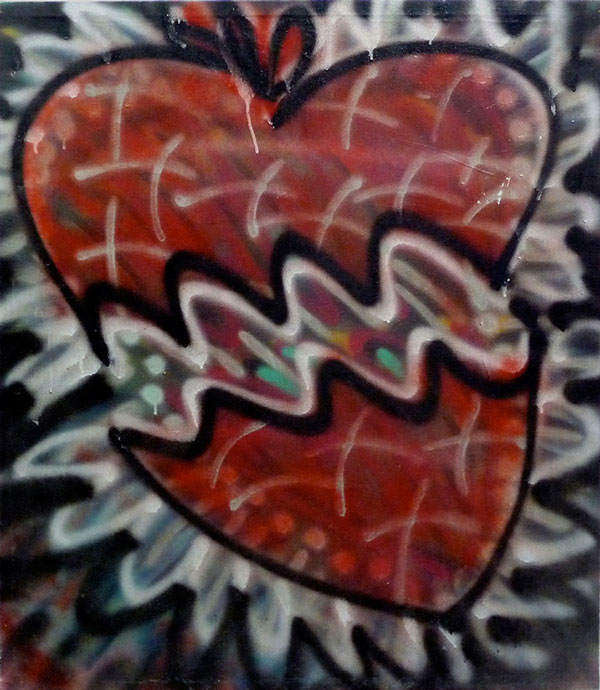Chicano art is at once a unified cultural expression and an ever-changing record of social and geographic situation. But regional inflections invariably emerge—and, certainly in the case of Chicano art in Los Angeles, regional inflection has profoundly impacted thought as well as production. Frank Romero, for one example, represents his place as well as his people. The retrospective he now enjoys at MOLAA also demonstrates that Romero does so by maintaining a focused stylistic and thematic self-definition. He has a “look,” and that look serves his own identity as an artist as well as that of Chicanismo as a cultural entity. But a key part of that look, and that identity, is identification with, even reliance on, Los Angeles.
The survey often seems as if it is trying to decide whether its subject is an artist or a Chicano. But, then, that dichotomy, false as it is, also describes the regard the art world has long had for Romero and his peers. The retrospective, it would seem, reflects that (rather demeaning) either/or attitude. This may be misinterpreted as careless and obtuse on the organizers’ part, but in fact it is deliberate and pointed, a deconstruction of a broad fallacy.
Ultimately, though, it’s the work itself, and Romero’s artistic evolution, that discredit the condescending approach. A small collection of Romero’s early work, even juvenilia, opens the show, collecting drawings, prints, paintings, collages, etc., into a testament to the young man’s skills and debts (he fancied cubism). What pops out, however, are Romero’s powers of observation, nowhere better marshaled than in several extraordinary photographs of people and structures in his life.

Frank Romero, Corazon Quebrado, 1996, courtesy of Cheech Marin, image courtesy of Cheech Marin.
Romero hit his stride, and gained his audience, when he became one of Los Four, a quartet of Chicano painters who took technical, stylistic, and thematic cues from Los Angeles barrio street art. This included painting with spray cans, conjuring religious and folkloric symbols (notably the heart) with his signature bold line and color. Romero’s Los Four work (and that of los otros Tres, Carlos Almaraz, Gilbert “Magu” Lujan, and Robert “Beto” de la Rocha) defiantly celebrated graffiti as a legitimate, indeed vital, artistic impulse—not quite to the extent of a Chas Bojorquez, but notably near.
In the wake of Los Four’s assertive 1970s claim to the limelight, Romero locked in his vocabulary of signs—hearts, palm trees and those ubiquitous Chrysler Airflow (and by inference low-rider) cars—and sealed his reputation with them (but not on them). Although he might make carvings and ceramics and whatnot with those cars, Romero did not turn them or the hearts or any of his other recurring motifs into branding devices. You always get the feeling—certainly to judge by the selection in the survey—that, far from cynically exploiting them, Romero regards his insignia-like motifs as old friends. Certainly, they help him maintain his high-voltage fantastical memory- and urgency-tinged imagination as he reconstructs moments of almost hallucinatory delight employing those instantly recognizable stuttering contours and lollipop colors.
“Delight” is the operative term here. Even when depicting events as fraught and tragic as the Death of Rubén Salazar (1986) or The Arrest of the Paleteros (1996), Romero keeps his palette shrill and electric, emulating the harsh, distorting artificial light in which the barrio’s main drags are bathed at night. This acid luminosity has become a hallmark of Romero’s art almost as indelible as the hearts and the low-rider cars. Romero loves working on a large scale, flexing his pictorial ambitions. Indeed, one section of the retrospective is devoted to “History Paintings,” which—like the academic grandes machines on which they’re based—brim with detail, none of it superfluous, even as they stretch across yards of wall.
But Romero is equally an intimist, realizing that play comes in all sizes and—to judge from the painted ceramics, carved wood, and other charming follies—all shapes. The most insistent characteristic of Romero’s oeuvre is not its graphic feel—it does not usually indulge the eye, but jangles it—but graphic description. That is, Romero is always making a picture of something, and quite often that picture is a reflection of hard urban reality—a Los Angeles urban reality dominated by cars and freeways. Its near-cartoon simplifications may soften the edges of Romero’s subject matter, but only just enough to allow us in in the first place.
“Dreamland” won’t change one’s feelings about Frank Romero’s art; it’s ever a love it or leave it kind of work, willing and able to be sassy, saccharine, and foreboding at the same time. What the retrospective gives us is a sense of Romero’s descriptive range, finally allowing both him, and the vida-loca Chicanismo he portrays, resonance, seriousness, and dignity.


